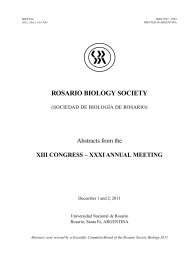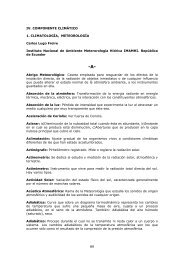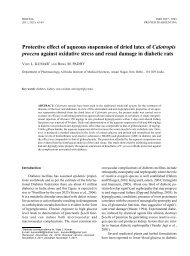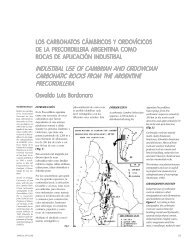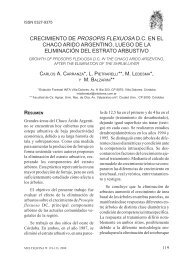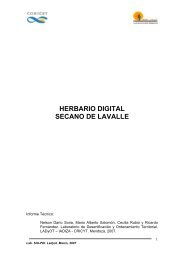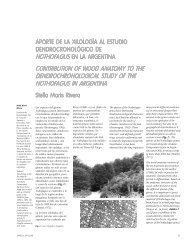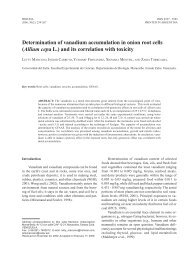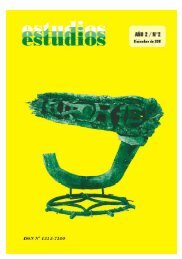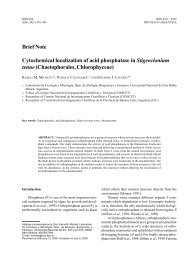XXII Annual Scientific Meeting, Tucuman Biology Society ...
XXII Annual Scientific Meeting, Tucuman Biology Society ...
XXII Annual Scientific Meeting, Tucuman Biology Society ...
You also want an ePaper? Increase the reach of your titles
YUMPU automatically turns print PDFs into web optimized ePapers that Google loves.
186 ABSTRACTS<br />
81.<br />
LEAF EPIDERMIS OF CHUSQUEA AND RHIPIDOCLADUM<br />
(POACEAE, BAMBUSEAE) FROM TUCUMAN PROVINCE<br />
Parrado MF 1 , De Marco N 2 .<br />
1 Fundación Miguel Lillo. Miguel Lillo 251. 2 Facultad de Agronomía<br />
y Zootecnia de la Universidad Nacional de Tucumán. Avda. Roca<br />
1900. (4000) San Miguel de Tucumán.<br />
E- mail: ronqui@arnet.com.ar<br />
Chusquea Kunth and Rhipidocladum McClure are American genus<br />
of shrubby bamboos. Both of them are represented in Tucumán<br />
Province including one species each, Chusquea lorentziana Griseb.<br />
and Rhipidocladum neumannii Sulekic, Rugolo & L. G. Clark. The<br />
objectives of this paper are: to describe the abaxial and adaxial leaf<br />
epidermis of Chusquea lorentziana Griseb. and Rhipidocladum<br />
neumannii Sulekic, Rugolo & L. G. Clark. and also to determine<br />
the micromorrphologic characters of taxonomic value to differentiate<br />
both entities. Observations were accomplished by means of<br />
optical and scanning electron microscopy. The following elements<br />
are described on the abaxial and adaxial epidermises: costal and<br />
intercostal zones, long cells, short cells, stomata, macro-hairs, micro-hairs,<br />
prickles and papillae. The diagnosis micromorphologic<br />
characters are the differentiation of costal and intercostal zones,<br />
estomata and macro-hairs. The analysis of the epidermises in surface<br />
view of both species revealed that differentiation characters<br />
do exist for identification.<br />
82.<br />
RAPHANUS SATIVUS L. (nabón), A WEED WITH<br />
FUNGITOXIC ACTIVITY<br />
Sgroi NA 1 , Selis AN 2 , Vattuone AM 3 , Quiroga EN 3 .<br />
1 Cátedra de Química Analítica; 2 Cátedra de Física II, Facultad de<br />
Agronomía y Zootecnia. UNT. Av. Roca 1900. 3 Cátedra de<br />
Fitoquímica, Instituto de Estudios Vegetales “Dr. R. Sampietro”,<br />
Facultad de Bioquímica, Química y Farmacia. Ayacucho 471. UNT.<br />
San Miguel de Tucumán. Argentina. E-mail: nsgroi31@hotmail.com<br />
/ insveg@unt.edu.ar<br />
The search of new substances with antifungal activity to be applied<br />
to protec plants and to preserve food and feed is an important<br />
task. The aim of our work was the search of fungitoxic principles<br />
present in Raphanus sativus L. (nabón). R. Sativus L. is a weed<br />
that spontaneously grows in the northwest of Argentina. The used<br />
phytopathogenic and xylophagous fungi and yeasts were isolated,<br />
identified and conserved in the Cát. de Fitoquímica, Fac. de Bioq.,<br />
Qca. y Fcia., UNT. Ethanolic and aqueus extracts were prepared<br />
from dry flowers. The biological activity was determined by bioautography,<br />
radial growth tests and growth zonal inhibition. The<br />
tincture was the most active preparation. Bioautographic assays<br />
showed different degrees of growth inhibition on the outlined fungi.<br />
Radial growth of xylopha gous fungi was inhibited between 30-<br />
92% with 0,15 mg of phenolic compounds/mL in the culture medium.<br />
The behavior of phytopathogenic fungi and yeasts was variable<br />
(21-100% of inhibition). Fungal zonal inhibition showed that<br />
the tincture extract has a high inhibition on Aspergillus nomius VSC<br />
23 and Aspergillus flavus. Our results revealed the presence of<br />
biomlecules with activity in the ethanolic extracts of Raphanus<br />
sativus L. (nabón).<br />
BIOCELL 30(1), 2006<br />
83.<br />
PREVAILING OF NON-LIPIDICS CARDIOVASCULAR<br />
RISK FACTORS IN A POPULATIONS OF STUDENTS<br />
Cardinale M, Coromina E, Olmos Fassi J, Morales M, Coviello A,<br />
Bianchi J.<br />
Facultad de Odontología (UNT). Avda. Benjamin Araoz 800. S.M.<br />
de Tucumán. E-mail: marcecardi@hot mail.com<br />
Introduction: Cardiovascular disease is the main cause of death<br />
in industrialized countries.<br />
Objective: To know prevailing of nonlipidics cardiovascular risk<br />
factors in a population of students of both sexes between 19 and 25<br />
years.<br />
Materials and methods: The population was of 195 women and<br />
66 men. Corporal mass index, a questionnaire to register familiar<br />
antecedents of cardiovascular morbid-mortality, arterial pressure<br />
and heart rate in 3 opportunities were registered. Results: a significant<br />
difference for values of systolic, diastolic, mean arterial<br />
pressure, and coroporal mass index (p



